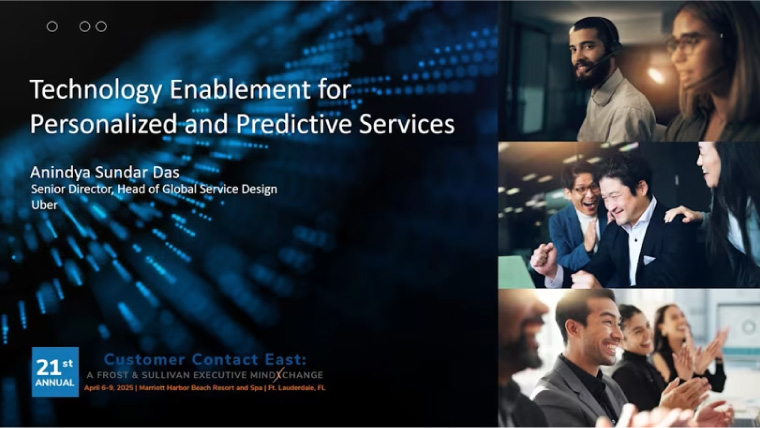At the 18th Annual Customer Contact East: A Frost & Sullivan Executive MindXchange, participants chose between six interactive brainstorming sessions and crowdsourced solutions to some of today’s most pressing customer service challenges. Read on for key ideas and suggestions generated from the first three sessions -great insights and ideas you can implement right now:
THE FIX ON DOING MORE WITH LESS
Natalia Brown, Chief Client Operations Officer, National Debt Relief
This session challenged participants to come up with solutions for organizational issues such as a deficit in resources or poor employee engagement. Suggestions for facilitating innovative ideas and attaining better executive support included:
Low-cost solutions for employee engagement in remote/hybrid environments:
- Crowdsource ideas and use a bottom-up approach
- Leverage free survey tools to get agent feedback on how they want to be engaged with
- Create voluntary social hours driven by employees
- Ideas included book clubs, TV show break rooms/chats, philanthropy talk spaces, podcasts, a newsletter club etc.
- Create office hours for small groups to engage with leadership
- Host in person events at least once a year
- Create peer- to- peer recognition programs with or without rewards… the goal is to praise anyone living company values
- Create virtual coffee/ water cooler break rooms
- Allow agents to join breakout rooms to chat during their breaks as they would in the office
- Leverage time you already spend with employees to get their feedback
- Create engagement teams to empower agents
- Design and send an annual survey to all agents seeking innovative ways to improve the business; communicate transparently every step of the way
- Be sure to implement some of the ideas and allow agents to join the project team
Low-cost solutions for training and development or change management:
- Leverage a buddy program pairing tenured agents with new agents
- Designate virtual partners in remote environments
- Create virtual office hours for learning and clarification on new policies or changes
- Leverage agents who can grow into roles by giving them more responsibilities as your business scales
- Add up-and-coming agents to meetings to further develop their reasoning and understanding of the business
- Give leaders a framework… they may not know what to do in every situation but give them foundational best practices i.e., we always do what is best for the client
- Remember, the best performer is not always the best leader, define what leadership means in your organization and select based on those attributes
- Be mindful of how many changes you implement over time and know your team – create space for questions, practice and coach through failures supportively
Solutions to getting the resources you need:
- Avoid being the call center dumping ground by:
- Setting clear timetables for proper execution
- Presenting data and ROIs that align with organizational strategies
- Adding structure to new requests and including all stakeholders
- Being proactive in communicating successes and challenges with executives
- Inviting executives to the production floor; this can help demonstrate the need for additional resources and/or create executive champions for your solutions
- Leveraging talent on your existing team and keep track of talent profiles for special projects
THE FIX ON SECURING SENSITIVE DATA ACROSS DISPERSE LOCATIONS
Wes Dudley, Vice President of Customer Experience, Broad River Retail
- What defines a dispersed location?
- Geographic
- Location of data storage
- Where does it terminate?
- Physical location
- Call Center
- BPO
- Sensitivity
- PCI
- PII
- SPII
- Soc2
- Type 2
- HIPAA
- Compliance – GDPR
- Need PCI champions in your company
- Audience (Who) – Internal or external
- Primary or Secondary
- In-Transit vs At-Rest
- Masking data
- Geographic
- Operational
- Know the data
- Protect the data
- What happens when data is lost or compromised (exposed)?
- How to recover?
- Access control – Some differences between in office and remote
- Client preference
- In-office workers treated the same as remote workers?
- What are the contractual aspects?
- Scenario Plan
- Business Continuity Plan
- Data Recovery
- IRP
- Regulated: Source, Transferred, Storage
- Life cycle management
- Opt In/Opt Out for calls/texting (Marketing/Transactional)
- Verbal consent on call
THE FIX ON TECHNOLOGY ADOPTION
Jeff Grant, Senior Product Owner, Enterprise Contact Center, Southwest Airlines
- Communication
- Initial Communication
-
- Provide the “what” we intend to do
- Provide the “why” we intend to do
-
- Cast the widest net on your communication
-
- Best to include everyone, and then let those not involved fall out, rather than miss someone
-
- Make the communication frequent and timely. Do not leave your stakeholders wondering about the status of the work
- Be transparent in your communication
- Initial Communication
-
- Identify your stake holders
- Build trust
-
- Business Customers
- Allow them to voice their requirements
- Give them ownership of the requirements
- Bottom up approach or top down approach?
- Remain flexible in your asks.
- Business Customers
-
- Technology Customers
- Encourage open discussions and allow for healthy conflict
- Ensure what is being built meets the needs
- Do not over engineer the product or the solution
- Set the stage for open dialogue
- Allow for healthy conflict
- Set and agree on scope
- Determine the design and implementation
- Technology Customers
-
-
- Work with the business to communicate the new product/feature
- Designate a champion on the business side to help with user concerns and fears
- Explain the reasons for change
- Engage training for CBT or class led instruction
- Setup an Experience Lab
-
2. Build relationships
3. Collaboration
4. Change Management
Stay tuned for Part Two of this series – including more great insights and road-tested “fixes” from industry leaders – to be featured in the August Customer Engagement Newsletter.



